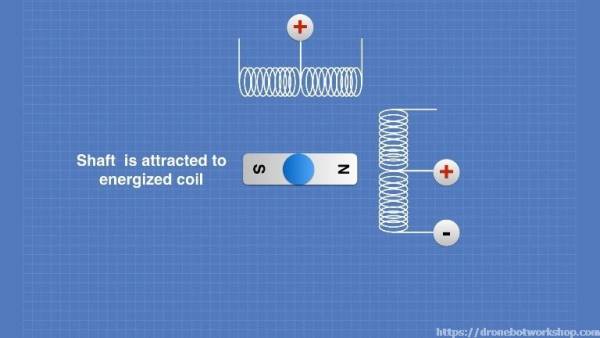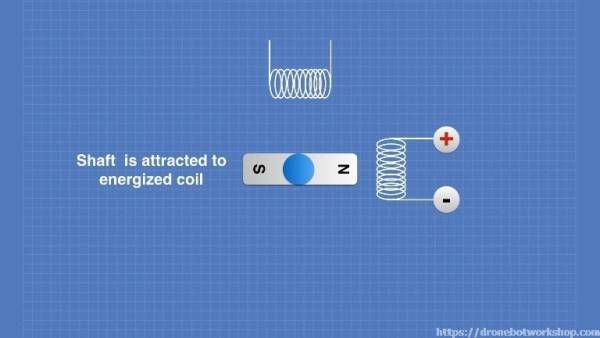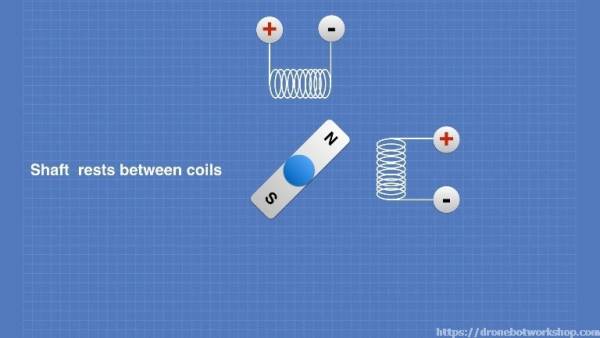This is an old revision of the document!
Table of Contents
Stepper Motors
Stepper motors allow for the fine control of rotations and can provide high torque at low speeds. With modifications to their control signals, they can be used to complete up to ¼ of their rated rotation accuracy, allowing for an even higher level of rotational accuracy if needed. They contain no feedback mechanisms which keeps their price low but also makes their position unaware upon turning on, so calibration circuitry may be necessary.
Compared to other motor types, stepper motors have a high number of magnetic poles. These poles are can be modified with each pulse like other motors, however, this high number of poles will result only in a small step as opposed to a larger rotation. This helps them maintain high rotational accuracy, and to maintain a high torque at resting or low operational speeds. However, this torque will drop off as the speed of rotations are increased.
Defining Characteristics
There are two defining operational characteristics of stepper motors. The first characteristic is based on the magnetization of the shaft, which can be referred to as a permanent magnet, variable reluctance, or hybridization of these two systems. A permanent magnet is a shaft that has a permanent magnetization, thus an unchanging north and south pole running parallel to the rotor shaft. This results in motors with strong torque even when the system is not powered and overall higher torque than variable systems, though this suffers at higher speeds. Variable reluctance motors have a non-magnetized toothed iron rotor. This produces less torque at low speeds and none when the system is not powered, though they have overall less torque fall-off at high speeds. However these, systems can often be noisy, particularly at higher speeds. Most common today are hybrid motors, which use a magnetized toothed rotor inside of a ring of magnetized teeth, which are offset from the rotor’s teeth based on their polarity. This provides systems with a large number of poles, increasing rotational accuracy. However, this more complex design makes them the most expensive of the bunch.
Second is the power source of the coils, where it can either be Unipolar or Bipolar setups. A Unipolar motor will keep all coils inside of the motors positive, with a negative charge being applied to only one coil. The motor shaft will rotate to align with the negatively charged coil, which can then be changed to continue to rotate the motor.
In a Bipolar setup, the charge of each coil is changed with every step. This generally more efficient as it uses the whole coil, but requires more complex control circuitry to operate.
Microstepping
With some minor modifications to the control signal, a half step or “micro-stepping” may be performed. Through partially charging the coils or charging multiple coils or other methods, a motor can perform, and be held in, a half, quarter, or smaller step, effectively doubling or quadrupling its rotational accuracy. This will of course reduce the holding torque at those positions proportionally. If controlled by a microcontroller, micro-stepping will also greatly increase computation load, so a specialized board such as the ULN2003 or A4988 may be desirable.
The accuracy of microstepping is not always correct, however. A more in-depth exploration of this topic can be found here 5)
Specifications
Retail stepper motors are required to provide several specifications, including Phase, Step Angle, Voltage, Current, Resistance, Inductance, Holding Torque, Detent Torque, Shaft Style and NEMA size.
Phase
The Phase specifies how many groupings of coils are implemented in the design of a motor. While a stepper motor will have multiple coils, they are grouped together for control purposes, with 2, 5 and 7 being the most common groupings.
Step Angle
The Step Angle will specify the rotation size of one step of the motor, represented as an angle. This may also be referred to as Steps per Revolution, which specifies the number of steps in one 360° rotation.
Voltage, Current & Resistance
Voltage, Current, and Resistance refer to the voltage, current, and resistance rating of the motor coils.
Inductance
The Inductance refers to the inductance of the motor coils, measured in millihenries. Inductance is important as it limits the maximum speed you’ll be able to drive your motor. Unipolar stepper motors have an advantage as they only use half a coil and thus have lower inductance than their bipolar equivalents.
Holding & Detent Torque
Holding Torque refers to the amount of force that is created when the stepper motor is powered, with Detent Torque referring to the amount of force when it is not.
Shaft Style
The Shaft Style refers to the physical shape of the motor shaft. This is important if you plan on hooking up the motor shaft to other systems, such as gears or pulleys.
NEMA size
The NEMA (National Electrical Manufacturers Association) size standard is used to measure the size of the motor. It can be approximated to be about the diameter of a motor in inches, multiplied by 10. Thus a NEMA 17 motor is about 1.7 inches in diameter. More info can be found at 6)
Applications
Stepper motors can be used in a wide variety of applications. They are frequently used in devices like printers, where low-speed rotational speed is valued. Their high torque at low rotational speeds also makes them great for haptics, such as their use in TorqueTuner (Kirkegaard et al., 2020) and the Haply system (Ding and Gallacher 2018), tool kits for implementing haptics into other devices.
Videos
Here's a tutorial on getting stepper motors up and running with an arduino
Products
| Company | Tropical Labs |
|---|---|
| Model | Mechaduino 0.2 |
| Sources | Tropical Labs Store US$ 65.00 |
| Description | A fully assembled control board, and NEMA 17 motor |
| Manual | https://tropical-labs.com/wp-content/uploads/2018/10/MechaduinoManual0.1.2.pdf |
References
“All About Stepper Motors.” n.d. Adafruit Learning System. Accessed March 23, 2021. https://learn.adafruit.com/all-about-stepper-motors/what-is-a-stepper-motor.
“How Accurate Is Microstepping Really?” Hackaday (blog). August 29, 2016. https://hackaday.com/2016/08/29/how-accurate-is-microstepping-really/.
“Choosing the Right Motor for Your Project - DC vs Stepper vs Servo Motors.” 2019. Latest Open Tech from Seeed Studio (blog). April 1, 2019. /blog/2019/04/01/choosing-the-right-motor-for-your-project-dc-vs-stepper-vs-servo-motors/.
Ding, Steven, and Colin Gallacher. 2018. “The Haply Development Platform: A Modular and Open-Sourced Entry Level Haptic Toolset.” In Extended Abstracts of the 2018 CHI Conference on Human Factors in Computing Systems, 1–4. Montreal QC Canada: ACM. https://doi.org/10.1145/3170427.3186512.
“How to Use Stepper Motors from Old Printers, Identify Pin Outs, Arduino Code.” n.d. Accessed March 24, 2021. https://anthscomputercave.com/recycling/stepper/use_stepper_motors_from_printers.html.
Kirkegaard, Mathias, Mathias Bredholt, Christian Frisson, and Marcelo M Wanderley. 2020. “TorqueTuner: A Self Contained Module for Designing Rotary Haptic Force Feedback for Digital Musical Instruments,” 6.
Lackey, Bill. 2018. “What’s the Difference Between Servo and Stepper Motors?” Machine Design. June 24, 2018. https://www.machinedesign.com/mechanical-motion-systems/article/21836868/whats-the-difference-between-servo-and-stepper-motors.
Motion Control Online Marketing Team. “Servo Motors vs. Stepper Motors in Motion Control: How to Choose the Right One for Your Application.” MCMA - Motion Control Online. Accessed March 23, 2021. https://www.motioncontrolonline.org/blog-article.cfm/Servo-Motors-vs-Stepper-Motors-in-Motion-Control-How-to-Choose-the-Right-One-for-Your-Application/34.
“Stepper Motors: Permanent Magnet, Variable Reluctance, and Hybrid.” 2018. Linear Motion Tips. April 26, 2018. https://www.linearmotiontips.com/stepper-motors-differences-between-permanent-magnet-variable-reluctance-and-hybrid-types/.
“Tutorial: Stepper vs Servo.” Accessed March 23, 2021. https://www.amci.com/industrial-automation-resources/plc-automation-tutorials/stepper-vs-servo/.
DroneBot Workshop. 2018. “Stepper Motors with Arduino – Bipolar & Unipolar.” DroneBot Workshop. February 10, 2018. https://dronebotworkshop.com/stepper-motors-with-arduino/.



